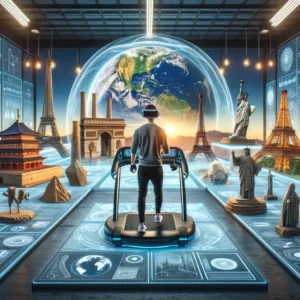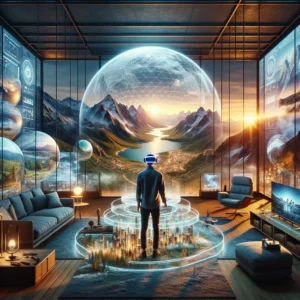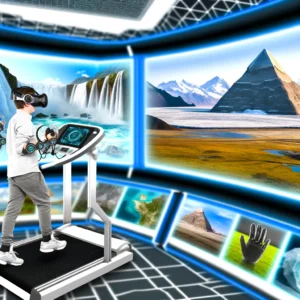In the realm of virtual reality (VR) travel experiences, the future holds boundless possibilities, promising to revolutionize the way we explore the world and beyond. As technology continues to advance at an exponential pace, VR travel enthusiasts are poised to embark on a journey of unprecedented immersion, innovation, and discovery. Join us as we delve into the exciting landscape of the future of VR travel, exploring the transformative technologies, groundbreaking applications, and visionary concepts that will shape the way we experience the world in the decades to come.
I. Advancements in Immersive Technology
1.1 Next-Generation Headsets: Pushing the Boundaries of Realism
The next generation of VR headsets promises to deliver unparalleled levels of realism and immersion, with advancements in display technology, optics, and tracking systems. From ultra-high-resolution displays and wide field-of-view lenses to eye-tracking and foveated rendering, these cutting-edge devices will transport users to virtual worlds with unprecedented clarity, detail, and presence, blurring the line between reality and illusion like never before.
1.2 Haptic Feedback: Engaging the Senses Beyond Sight and Sound
Haptic feedback technology is poised to revolutionize the sensory experience of VR travel, allowing users to feel the virtual world in ways previously unimaginable. From tactile gloves and vests to full-body haptic suits, these devices will enable users to sense textures, temperatures, and even physical forces within virtual environments, enhancing immersion and presence and creating a truly multisensory experience that engages all the senses.
1.3 Spatial Audio: Creating a Richer Soundscape
Spatial audio technology will play a pivotal role in the future of VR travel, immersing users in a rich auditory landscape that complements the visual experience. With advancements in audio processing algorithms and spatialization techniques, users will be able to hear sounds emanating from their virtual surroundings with pinpoint accuracy, whether it’s the rustle of leaves in a virtual forest or the roar of waves on a virtual beach, further enhancing the sense of presence and realism.
1.4 Wireless Connectivity: Unleashing Freedom of Movement
Wireless connectivity will liberate VR travelers from the constraints of cables and tethers, enabling seamless, untethered exploration of virtual worlds. With the advent of 5G and beyond, users will be able to roam freely within expansive virtual environments, untethered from physical constraints, and limitations, allowing for truly immersive and unrestricted exploration of virtual destinations.
II. Expanding Horizons: From Earth to the Cosmos
2.1 Virtual Tourism: Exploring the World Without Leaving Home
Virtual tourism will continue to expand its reach, offering users the opportunity to explore destinations around the globe from the comfort of their own homes. From iconic landmarks and natural wonders to cultural heritage sites and historical landmarks, virtual tourists will be able to embark on virtual journeys to any corner of the Earth, experiencing the sights, sounds, and sensations of distant lands without ever stepping foot outside their door.
2.2 Space Tourism: Journeying Beyond the Final Frontier
The burgeoning field of space tourism will open up new frontiers for VR travel, allowing adventurers to venture beyond the bounds of Earth and explore the cosmos firsthand. From virtual visits to the International Space Station to immersive experiences on the surface of distant planets and moons, space tourists will be able to experience the wonders of space exploration in ways previously reserved for astronauts, pushing the boundaries of human imagination and aspiration.
2.3 Time Travel: Reliving the Past and Imagining the Future
Virtual reality will enable users to transcend the constraints of time, allowing them to journey into the past and future with unprecedented fidelity and detail. From immersive reconstructions of ancient civilizations and pivotal moments in history to speculative visions of distant futures and alternate realities, VR time travel experiences will offer users the chance to explore the full breadth of human history and imagination, gaining new insights and perspectives along the way.
2.4 Fantasy Worlds: Unleashing Creativity and Imagination
Beyond the confines of reality, virtual reality will unlock the limitless possibilities of the imagination, allowing users to explore fantastical worlds and realms of pure fantasy and wonder. From enchanted forests and mythical kingdoms to alien planets and parallel dimensions, VR fantasy experiences will transport users to realms where the laws of physics and logic are suspended, inviting them to unleash their creativity and explore the boundless depths of the human imagination.
III. Social Interaction: Connecting Across Boundaries
3.1 Social VR: Building Communities in Virtual Spaces
Social VR platforms will emerge as vibrant hubs of virtual social interaction, enabling users to connect, communicate, and collaborate with others from around the world in immersive virtual environments. From virtual meetups and live events to multiplayer games and collaborative projects, social VR will foster new forms of community and camaraderie, transcending physical boundaries and bringing people together in shared virtual spaces.
3.2 Virtual Events: Redefining the Experience of Gatherings
Virtual events will redefine the way we gather and celebrate, offering immersive, interactive experiences that transcend the limitations of traditional physical gatherings. From virtual concerts and festivals to conferences and expos, these events will enable participants to engage with content and each other in new and innovative ways, fostering connections and collaborations that transcend geographical distance and logistical constraints.
3.3 Virtual Tourism: Exploring Together in Shared Spaces
Collaborative virtual tourism experiences will allow groups of users to explore virtual destinations together in shared virtual spaces, fostering collaboration, communication, and shared experiences. Whether it’s a family exploring the wonders of the Great Barrier Reef or a group of friends embarking on a virtual road trip across the United States, collaborative VR tourism experiences will create opportunities for shared discovery and adventure, strengthening bonds and creating lasting memories.
3.4 Cultural Exchange: Bridging Gaps and Fostering Understanding
Virtual reality will become a powerful tool for cultural exchange and understanding, enabling users to explore diverse cultures, languages, and perspectives in immersive virtual environments. From virtual language exchanges and cultural workshops to collaborative art projects and storytelling sessions, VR will facilitate cross-cultural dialogue and interaction, fostering empathy, respect, and appreciation for the rich tapestry of human diversity.

IV. Challenges and Considerations
4.1 Ethical Implications: Navigating Privacy, Consent, and Representation
As VR travel becomes increasingly immersive and pervasive, it will raise important ethical questions around privacy, consent, and representation. Developers and users alike will need to navigate complex issues related to data privacy, informed consent, and the ethical representation of individuals and cultures within virtual environments, ensuring that VR experiences are respectful, inclusive, and responsible.
4.2 Accessibility: Ensuring Equal Access for All
Accessibility will be a key consideration in the future of VR travel, as developers strive to ensure that immersive experiences are accessible to users of all abilities. From designing interfaces and interactions that accommodate diverse needs to providing alternative modes of access for users with disabilities, accessibility considerations will play a crucial role in shaping the inclusivity and diversity of VR travel experiences.
4.3 Digital Divide: Addressing Disparities in Access and Infrastructure
The digital divide will remain a significant barrier to widespread adoption of VR travel, particularly in regions with limited access to high-speed internet and advanced technology infrastructure. Bridging this gap will require concerted efforts to expand broadband access, reduce costs, and increase awareness and education around the potential benefits of VR technology, ensuring that all communities have the opportunity to participate in the virtual travel revolution.
4.4 Environmental Impact: Minimizing Footprint and Sustainability
As VR travel continues to grow in popularity, it will be important to consider its environmental impact and sustainability. While virtual travel offers a more eco-friendly alternative to traditional tourism, it still requires energy and resources to produce and consume. Developers and users will need to prioritize sustainability, minimizing energy consumption, reducing carbon emissions, and supporting renewable energy sources to ensure that VR travel remains a responsible and sustainable option for exploring the world.
V. Conclusion: Embracing the Future of Virtual Reality Travel
As we look to the future of virtual reality travel, it’s clear that we stand on the brink of a new era of exploration, innovation, and possibility. From next-generation immersive technologies and expansive virtual destinations to collaborative social experiences and ethical considerations, the future of VR travel holds immense promise and potential for transforming the way we explore the world and connect.
VI. Legal and Regulatory Frameworks
6.1 Intellectual Property Rights: Protecting Creators and Content
As the virtual reality travel industry expands, legal frameworks surrounding intellectual property rights will become increasingly important. Developers and content creators must navigate copyright and trademark laws to ensure that their creations comply with legal standards while also respecting the rights of original creators and cultural heritage. Clear guidelines and licensing agreements will help establish a fair and transparent ecosystem for virtual reality content.
6.2 Data Privacy and Security: Safeguarding User Information
The collection and use of user data in virtual reality travel experiences raise significant privacy and security concerns. Developers must implement robust data protection measures to safeguard sensitive information and ensure user trust and confidence. Compliance with international privacy regulations, such as the GDPR and CCPA, will be essential to maintaining ethical standards and protecting user privacy in the virtual realm.
6.3 Regulatory Compliance: Adhering to Industry Standards
As virtual reality travel becomes increasingly integrated into the global tourism industry, adherence to regulatory standards and industry best practices will be paramount. Developers and operators must comply with safety, accessibility, and consumer protection regulations to ensure the integrity and reliability of virtual travel experiences. Collaboration with regulatory bodies and industry stakeholders will help establish guidelines and standards that promote responsible and sustainable VR travel.
VII. Education and Training Applications
7.1 Virtual Learning Environments: Enhancing Education Access
Virtual reality will revolutionize education and training by providing immersive and interactive learning environments accessible to students worldwide. From virtual classrooms and laboratories to historical reenactments and cultural simulations, VR technology will democratize access to quality education, empowering learners of all ages and backgrounds to explore, experiment, and collaborate in virtual spaces that transcend the limitations of traditional learning settings.
7.2 Professional Development: Upskilling and Reskilling in VR
Virtual reality offers unparalleled opportunities for professional development and skills training across industries. From virtual job interviews and workplace simulations to technical training modules and collaborative project spaces, VR enables employees to acquire and hone essential skills in a safe and immersive environment. As the demand for digital literacy and remote work skills grows, VR training programs will play an increasingly critical role in preparing the workforce for the jobs of the future.
7.3 Cultural Preservation: Digitizing and Preserving Heritage
Virtual reality has the potential to revolutionize cultural preservation efforts by digitizing and immersive heritage sites, artifacts, and traditions. From ancient ruins and archaeological sites to endangered languages and intangible cultural heritage, VR technology offers a powerful tool for documenting, preserving, and sharing cultural treasures with future generations. By harnessing the power of VR, communities can safeguard their cultural heritage and promote cross-cultural understanding and appreciation on a global scale.
VIII. Health and Wellness Applications
8.1 Therapeutic Interventions: Harnessing VR for Healing
Virtual reality has emerged as a promising tool for therapeutic interventions across a wide range of physical and mental health conditions. From pain management and rehabilitation to stress reduction and exposure therapy, VR experiences offer immersive and customizable interventions that engage patients in their healing process. As VR technology continues to advance, it holds the potential to revolutionize healthcare delivery and improve outcomes for patients worldwide.
8.2 Mindfulness and Meditation: Creating Calm in Virtual Spaces
Virtual reality can serve as a sanctuary for mindfulness and meditation practices, providing users with immersive environments conducive to relaxation and stress relief. From tranquil nature scenes and serene landscapes to guided meditation sessions and breathwork exercises, VR experiences offer a refuge from the stresses of daily life and an opportunity to cultivate inner peace and mental well-being. As interest in mindfulness and self-care grows, VR meditation apps and experiences will become increasingly popular tools for promoting mental wellness and resilience.
8.3 Physical Fitness and Recreation: Gamifying Exercise in VR
Virtual reality transforms exercise and recreation into immersive and engaging experiences that motivate users to stay active and healthy. From interactive fitness games and immersive workout routines to virtual sports and adventure simulations, VR offers a wide range of options for getting moving and having fun. As the fitness industry embraces VR technology, users can expect to see an explosion of innovative and entertaining experiences that make exercise more enjoyable and accessible to people of all ages and fitness levels.
IX. Environmental and Social Impact
9.1 Carbon Footprint Reduction: Reducing Travel Emissions
Virtual reality travel has the potential to significantly reduce the environmental impact of traditional tourism by eliminating the need for long-distance travel. By enabling users to explore destinations virtually, VR technology can help mitigate carbon emissions, alleviate pressure on fragile ecosystems, and preserve natural resources for future generations. As concerns about climate change and sustainability grow, VR travel offers a sustainable alternative that allows people to experience the world without leaving a negative footprint.
9.2 Social Inclusion: Breaking Down Barriers to Access
Virtual reality has the power to break down barriers to access and inclusion, providing people with disabilities, mobility limitations, and financial constraints the opportunity to explore the world in ways that were previously impossible. By creating inclusive and accessible virtual environments, VR travel promotes social equity and diversity, ensuring that everyone has the opportunity to participate in the global conversation and experience the richness of human culture and heritage.
9.3 Community Engagement: Fostering Global Connection
Virtual reality travel fosters global connection and community engagement by bringing people together in shared virtual spaces. Whether attending virtual events, collaborating on projects, or exploring virtual destinations with friends and family, VR technology enables people to connect and interact in meaningful ways across geographical and cultural boundaries. By fostering empathy, understanding, and collaboration, VR travel promotes a sense of global citizenship and solidarity, uniting people around common interests and aspirations.

X. Conclusion: Embracing the Virtual Frontier
As we embark on the journey into the future of virtual reality travel, we stand at the threshold of a new frontier of exploration, innovation, and possibility. From immersive technologies and expansive virtual destinations to educational applications and health and wellness interventions, the potential of VR travel to transform the way we experience the world is boundless.
By embracing the opportunities and addressing the challenges that lie ahead, we can harness the power of virtual reality to create a more inclusive, sustainable, and connected world for generations to come. Together, let us embark on this virtual voyage of discovery, guided by the spirit of exploration, curiosity, and imagination, as we chart a course toward a future where the wonders of the world are within reach of all who dare to dream.
